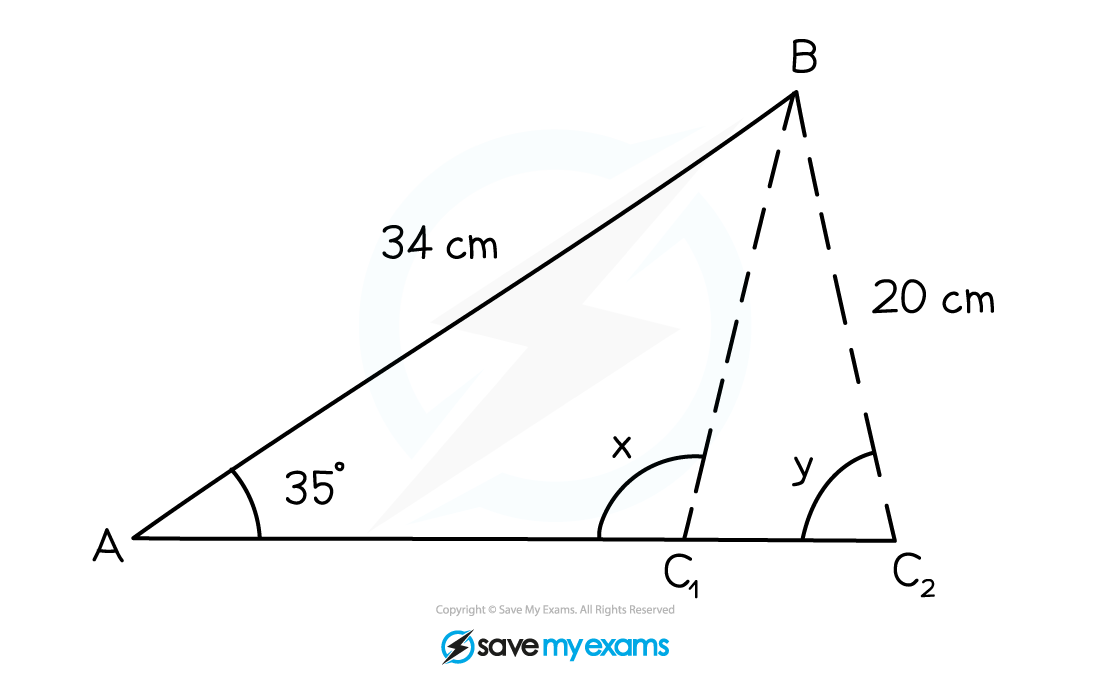Sine, Cosine Rule & Area of Triangles (AQA GCSE Further Maths): Revision Note
Exam code: 8365
Pythagoras' theorem and SOHCAHTOA only work in right-angled triangles
The Sine Rule and Cosine Rule allow us to answer triangle questions for ANY triangle
The Area of a Triangle Formula is an alternative to
Did this video help you?
Sine & cosine rules
What are the sine rule and cosine rule formulae?
Before applying these formulas it is useful to label the triangle using a system of 'opposites'

Note how lowercase letters are used for side lengths and capital letters for angles
make sure an angle and the side opposite it have the same letter
Sine Rule
sin 90° = 1 so if one of the angles is 90°, this becomes ‘SOH’ from SOHCAHTOA
The sine rule can also be 'flipped over'
This is more useful when we are using the rule to find angles
Cosine Rule
cos 90° = 0 so if A = 90°, this becomes Pythagoras’ Theorem
The cosine rule is 'cyclic' so there are two other versions of it
but once you are used to using cosine rule, there's only really one version
you just need to 'cycle' a, b and c around accordingly for a specific question
Note that it's always the angle between the two sides in the final term
Questions can become algebraic when side lengths are replaced by letters and expressions
Use the same rules but put brackets around expressions like (x + 3)
What is the ambiguous case of the sine rule?
In some circumstances, it is possible to get two possible answers using sine rule
this arises when the angle you are trying to find could be either acute or obtuse
Consider the triangle below

You know the pair a and A and half of the pair c and C (c = 34)
However there are two possible locations for the third vertex of the triangle (labelled C1 and C2)
So there are two possible angles for C (x and y on the diagram)
(Most) calculators will only give one answer when using inverse sine (
)
this will be the acute angle
if the obtuse angle is required, subtract the acute angle from 180°
Questions will state, or imply, whether the acute or obtuse angle is required
or could ask you to find both possibilities!
There is no 'ambiguous' case for the cosine rule
How do I know whether to use sine rule or cosine rule?
Sine rule is used when you know a 'pair' and half of the pair involving the unknown we are asked to find
e.g. a question may give us side a and angles A and B, then ask us to find side b
(you know the pair a and A, and half of the pair b and B)
Cosine rule is used in two circumstances
when questions gives us an angle and the two sides that make it
this allows us to find the side opposite the given angle
e.g. a question may give us sides b, c and angle A
(this would allow us to find the side a)
when questions give us all three sides of a triangle and we are required to find an angle
in this case the rearranged version of cosine rule may be helpful
then use inverse cos (
) to find A
you may prefer to substitute known values into the 'regular' version of cosine rule and then rearrange
Examiner Tips and Tricks
In trickier exam questions, you may have to use both the cosine rule and the sine rule
For the sine rule, if you are finding a side, use the version of the formula that has the sides on the numerators; if you are finding an angle, put the sines on the numerators
If your calculator gives you a ‘Maths ERROR’ message when trying to find an angle using the cosine rule, you probably subtracted things the wrong way around when you rearranged the formula
Worked Example
The diagram below shows a sketch of a triangle, where angle ACB is obtuse.

a) Show that the cosine of angle ABC is exactly
.
You know all three lengths and want to show a result involving cosine - so use cosine rule!
Substitute values into cosine rule
Evaluate where possible, ensuring not to round as an exact answer is required later
Rearrange to find an expression for
Use your calculator to write/check this fraction is the same as the required answer
b) A student uses the sine rule and the answer to part (a) to calculate angle ACB.
Their final answer, rounded to one decimal place is 73.0°.
Explain why the student's final answer cannot be correct and find the correct size for angle ACB.
Angle ACB is obtuse so
The answer 73.0° comes from using and a calculator will always give an acute angle
The question says angle ACB is obtuse
To find the correct angle we need to subtract 73.0° from 180°
180° - 73.0° = 107.0°
Angle ACB = 107.0° (1 d.p.)
This is commonly known as the ambiguous case of the sine rule
Area of a triangle
What is the area of a triangle formula?
The Area of a Triangle formula applies to any triangle set up using the system of 'opposites'

As with cosine rule, there are 'cyclic' alternatives to this
but rather than rememeber three formulae, remember one and change a, b and c accordingly
e.g.
sin 90° =1 so if C = 90°, this becomes
In genreal
allows us to find the area without having to know or find the height
it is particularly useful in non-right angled triangles
The questions encountered can be more algebra-based when side lengths are given as letters or expressions
use brackets around expressions like (x + 3)
check for any exact trigonometric values, like
Examiner Tips and Tricks
Try not to get bogged down in remembering different versions of the area of a triangle formula
Spot that to use
you need an angle and the two sides that form it
Worked Example
The diagram below shows triangle PQR where side PQ is 2x and angle P is 30°.
Given that the ratio of the sides PQ to PR is 2 : 3, find an expression for the area of the triangle in terms of x.

To use the area of a triangle formula we need two sides and the angle between them
So you need to find, in terms of x, the side PR using the given ratio
Now apply the area of a triangle formula
Simplifying the right-hand side including evaluating
(square units)
Applications of trigonometry
How do I choose which rule or formula to use
It is important to be able to decide which Rule or Formula to use to answer a question
This table summarises the possibilities:


What problems will I be asked to solve using trigonometry?
Problems in trigonometry may involve any, or more than one
Pythagoras' theorem
SOHCAHTOA
Sine rule
Cosine rule
Area of a triangle
Beyond 2D triangles you may be asked to solve problems involving
more complicated 2D shapes that have parts or sections that can be considered as a triangle
e.g. a trapezium
3D shapes that have triangular parts or features
e.g. a triangular prism, the cross section of a cone
Many problems will involve algebraic answers
sides may be given in terms of a variable such as x
you may be asked to find an expression for a length or area "in terms of x"
Problems may involve surds, arising from exact values to common trigonometric ratios
e.g.
You need to learn these exact values
Worked Example
The diagram below shows a cone with slant height of cm.
Given that angle ABC is 30°, show that the diameter of the base, cm, is given by the expression
.

BA = BC by symmetry
Draw a cross section through the centre of the cone and include any angles and lengths

Use the cosine rule with a = d, b = 2x, c = 2x and A = 30°
Simplify the powers and collect like terms
Use the exact value of cos 30 and simplify
Factorise out 4x2 on the right-hand side
Splitting the triangle into two right-angled triangles doesn't help with this question in a non-calculator paper (you do not know exact trig values for 15° or 75°)

Unlock more, it's free!
Did this page help you?